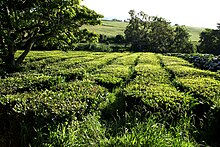<<GotoNote

Green tea is a type of tea that is made from Camellia sinensis leaves and buds that have not undergone the same withering and oxidation process used to make oolong teas and black teas.[1] Green tea originated in China, but its production and manufacture has spread to many other countries in Asia.
Several varieties of green tea exist, which differ substantially based on the variety of C. sinensis used, growing conditions, horticultural methods, production processing, and time of harvest. Although there has been considerable research on the possible health effects of consuming green tea regularly, there is little evidence that drinking green tea has any effects on health.[2]
Tea consumption has its legendary origins in China during the reign of Emperor Shennong.[3]
A book written by Lu Yu in 618-907 AD (Tang dynasty), "The Classic of Tea" (simplified Chinese: 茶经; traditional Chinese: 茶經; pinyin: chájīng), is considered important in green tea history. The Kissa Yojoki (喫茶養生記 Book of Tea), written by Zen priest Eisai in 1211, describes how drinking green tea may affect five vital organs, the shapes of tea plants, flowers and leaves, and how to grow and process tea leaves.
Steeping, or brewing, is the process of making tea from leaves and hot water, generally using 2 grams (0.071 oz) of tea per 100 millilitres (3.5 imp fl oz; 3.4 US fl oz) of water (H2O) or about 1 teaspoon of green tea per 150 ml cup. Steeping temperatures range from 61 °C (142 °F) to 87 °C (189 °F) and steeping times from 30 seconds to three minutes.
...https://en.wikipedia.org/wiki/Green_tea